
The Crassulaceae, also known as the stonecrop family or the orpine family, are a diverse family of dicotyledon flowering plants characterized by succulent leaves and a unique form of photosynthesis, known as Crassulacean acid metabolism (CAM). Flowers generally have five floral parts. Crassulaceae are usually herbaceous but there are some subshrubs, and relatively few treelike or aquatic plants. Crassulaceae are a medium-sized monophyletic family in the core eudicots, among the order Saxifragales, whose diversity has made infrafamilial classification very difficult. The family includes approximately 1,400 species and 34–35 genera, depending on the circumscription of the genus Sedum, and distributed over three subfamilies. Members of the Crassulaceae are found worldwide, but mostly in the Northern Hemisphere and southern Africa, typically in dry and/or cold areas where water may be scarce, although a few are aquatic.

The Rugosa, also called the Tetracorallia, rugose corals, or horn corals, are an extinct order of solitary and colonial corals that were abundant in Middle Ordovician to Late Permian seas.
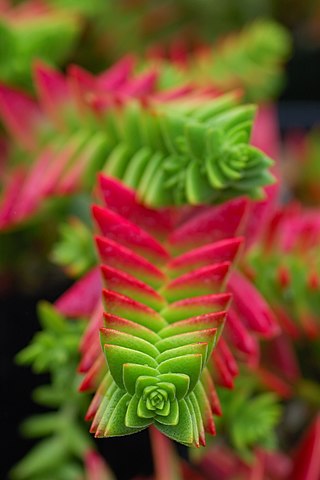
Crassula is a genus of succulent plants containing about 200 accepted species, including the popular jade plant. They are members of the stonecrop family (Crassulaceae) and are native to many parts of the globe, but cultivated varieties originate almost exclusively from species from the Eastern Cape of South Africa.

Crassula helmsii, known as swamp stonecrop or New Zealand pigmyweed, is an aquatic or semiterrestrial species of succulent plant in the family Crassulaceae. Originally found in Australia and New Zealand, it has been introduced around the world. In the United Kingdom, this plant is one of five introduced invasive aquatic plants that were banned from sale from April 2014, the first ban of its kind in the country. It is on the Global Biodiversity Information Facility's Global Register of Introduced and Invasive Species of eleven countries.

Crassula aquatica is a succulent plant known by the common names water pygmyweed, common pygmyweed and just pigmyweed. It is an annual plant of salt marshes, vernal pools, wetlands, and other fresh to brackish water bodies. It is at least partially aquatic, living in areas which are submersed much of the time. It also lives along muddy banks and in tidally-active areas of estuaries.

Crassula tillaea is a succulent plant known by its common names mossy stonecrop and moss pygmyweed. It is a small fleshy plant growing only a few centimeters in height. It is green when new and gradually turns orange and then deep red when mature. It has tiny triangular pointed leaves only a few millimeters long. A tiny flower or pair of flowers grows between each oppositely-arranged pair of leaves; the flowers are about two millimeters in length and width. The fruit is a minute follicle containing one or two seeds. This plant is native to Eurasia, particularly the Mediterranean Basin, but is known in other regions as an introduced species.
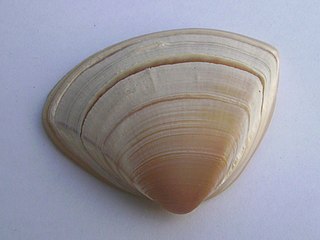
Crassula aequilatera, known as the triangle shell, is a surf clam, a moderately large marine bivalve mollusc in the family Mactridae.
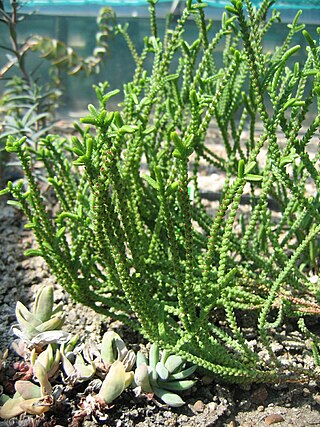
Crassula muscosa, synonyms Crassula lycopodioides and Crassula pseudolycopodioides, is a succulent plant native to South Africa and Namibia, belonging to the family of Crassulaceae and to the genus Crassula. It is a houseplant grown worldwide and commonly known as rattail crassula, watch chain, lizard's tail, zipper plant and princess pines.

Crassula capitella, is a perennial succulent plant native to southern Africa.

Crassula ovata, commonly known as jade plant, lucky plant, money plant or money tree, is a succulent plant with small pink or white flowers that is native to the KwaZulu-Natal and Eastern Cape provinces of South Africa, and Mozambique; it is common as a houseplant worldwide. Much of its popularity stems from the low levels of care needed; the jade plant requires little water and can survive in most indoor conditions. It is sometimes referred to as the money tree; however, Pachira aquatica also has this nickname.
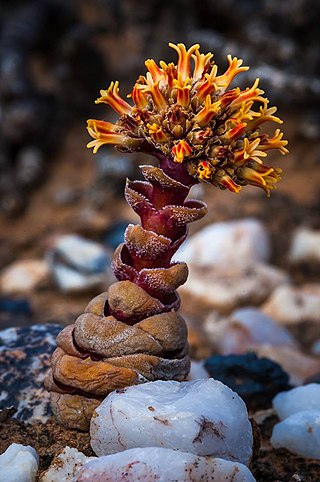
Crassula columnaris is a succulent plant native to South Africa and Namibia.
Hellmut R. Toelken is a South Australian botanist. He retired in December 2008 from the position of senior biologist at the State Herbarium of South Australia, but remains an honorary research associate. Earlier he was with the Botanical Research Institute, Department of Agricultural Technical Services, Pretoria, S Africa.

Crassula sarcocaulis is a small shrubby succulent plant known by the common name bonsai crassula, due to its bonsai-like appearance. It is a perennial plant native to the southern and southeastern Africa, ranging from Malawi and Mozambique through Zimbabwe, Swaziland, Lesotho, and South Africa. It grows on mountain slopes in rocky terrain.

Crassula biplanata is a succulent plant native to rocky ledges and mountainous areas in the southern parts of South Africa.
Asperula crassula is a species of flowering plant in the family Rubiaceae, endemic to a few hundred hectares in northeast Crete. It was first described in 1857.

Crassula vaillantii is a species of herb in the family Crassulaceae. They are succulents plants.

Crassula umbella is a succulent plant species in the genus Crassula. It is endemic to the Cape Provinces of South Africa.
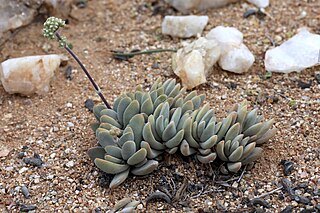
Crassula namaquensis is a species of succulent plant in the genus Crassula native to South Africa. Easily confused with some forms of Crassula tecta and Crassula sericea, this species has rounded to elongated leaves that are usually blue, covered in fine hairs, and form clumps.

Crassula corallina is a species of succulent plant in the genus Crassula from Central South Africa and Southeastern Namibia. It grows as mats in dry habitats and is typically short-lived.

















